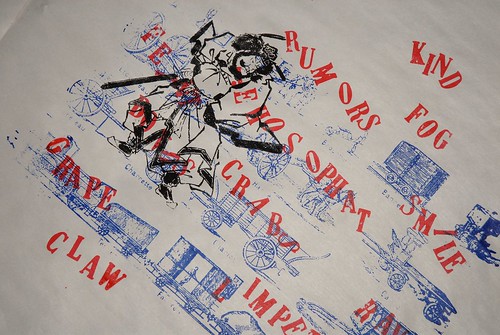Coming soon: Callithump! Broadside. A broadside, also known as a broadsheet, is a page 17″ X 22″. It’s the standard size for newspapers in the US, or at least it was before the cheesy 11″X17″ tabloid format started taking over. We’ll be screenprinting broadsides with special guests while we have them over for dinner in upcoming weeks.

We’d been wanting to do something in this format in homage to Robert Piser’s Daily Palette, the first publicly available art vending machine (that we know of). Once we started exploring, we discovered an interesting fact: Broadsheets were initially the domain of poets, artists and political activists. They became popular for newspapers in the early 1700s as a way to get around a newspaper tax that taxed papers based on the number of pages.
It’s time to take the format back! The time is ripe, since newspapers are abandoning the broadsheet in favor of the tabloid or the web.
It’s fun to work in a large format after being confined to capsules for so long! An advantage to newsprint is the the local paper gives us rolls of the stuff for free. This means our production costs are almost nothing, so we’ll be able to give Callithump! Broadsides away for free!
We’ve got a fun approach to creating these as well. It’s a variation on the Exquisite Corpse. We’re doing prints with multiple screens. The screens are done by different people who we’ve invited over for dinner, while we prepare dinner, eat, drink and make merry. The catch is, we don’t discuss the content of the prints beforehand, only the size limitations. The final result might blend nicely, or it might be a sticky mess. It’s gauranteed to be interesting!

If this sounds like fun to you, drop us a line and we’ll have you over for dinner! You are cordially invited!
If you live too far away from Brunswick, Maine to come join us, please try it on your own. Give your local newspaper a call and see if they give away remnants. We use silk screens, but really, any way to make a mark on paper will do. Let us know how it goes!
2 replies on “Prepare for Broadside!”
I am very familiar with Piser’s Berkeley-based “Daily Palette” and am delighted to see it recognized all these decades later. Piser’s newsstands made available the work of emerging and established at a price that I’m sure didn’t come close to covering the cost of production and distribution. The “Daily Palette” was, in itself, a work of art.
I do my best to spread the word about the Daily Palette! Sadly, so many works like this don’t get documented and all that remains of them is the oral history of people who were there. I’m trying to remedy that with my history of vending machine art, which I’m working to expand significantly, starting with the Daily Palette. Any information/insights you can share are greatly appreciated!